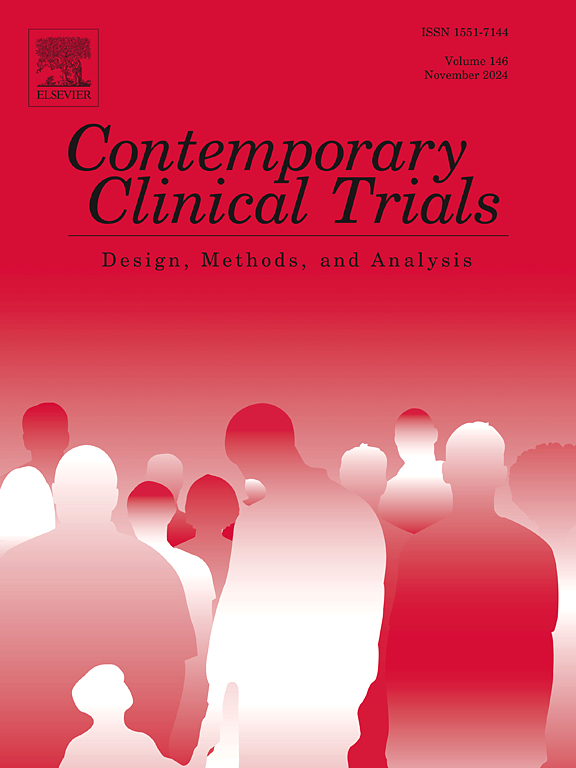Randomized controlled trial of a multiple technology-based physical activity intervention for Latina adolescents: Recruitment strategies and baseline data from the Chicas Fuertes trial
IF 2
3区 医学
Q3 MEDICINE, RESEARCH & EXPERIMENTAL
引用次数: 0
Abstract
Background
Latina adolescents report low levels of physical activity (PA) and high lifetime risk of lifestyle-related diseases. They also have high rates of using technology, suggesting interventions delivered through mobile devices may be effective for this population. The current paper describes recruitment methods and baseline study characteristics for Chicas Fuertes, a fully powered randomized trial of a mobile technology PA intervention.
Methods
Underactive Latina adolescents (aged 13–18) were recruited using social media and presentations at local schools and community organizations in San Diego, California. Participants were randomly assigned 1:1 to either the intervention (Fitbit, tailored texting, social media, and website) or control group. Baseline measures included demographics, psychosocial variables, and PA measured by the 7-Day Physical Activity Recall (PAR), ActiGraph GT3X+ accelerometers, and Fitbits. Baseline data were collected from 2020 to 2023.
Results
Social media yielded the most contacts (465), but had the lowest chance of enrollment (14 %, vs. 52 % from school presentations). Participants (N = 160) were mostly second generation (68.8 %), and low income (61.8 %), but technology access was high (>99 %). Median self-reported moderate-to-vigorous PA (MVPA) using the 7-Day PAR was 120 min/week (range 0–720), and median daily steps were 5222 (IQR 359). Median MVPA measured by ActiGraphs, however, was 0 min per week. There was no correlation between the 7-day PAR and ActiGraphs (. However, ActiGraph MVPA was correlated with total steps recorded by the Fitbit ().
Conclusions
Both remote and in-person approaches were successful in recruiting a sample that was underactive and low income, but had high technology use.
针对拉丁裔青少年的基于多种技术的体育活动干预随机对照试验:Chicas Fuertes 试验的招募策略和基线数据。
背景:拉丁裔青少年的体力活动(PA)水平较低,一生中患生活方式相关疾病的风险较高。他们使用技术的比例也很高,这表明通过移动设备进行干预可能对这一人群有效。本文介绍了 "Chicas Fuertes "项目的招募方法和基线研究特征:方法:通过社交媒体以及在加利福尼亚州圣迭戈市当地学校和社区组织的宣讲,招募缺乏运动的拉丁裔青少年(13-18 岁)。参与者按 1:1 随机分配到干预组(Fitbit、定制短信、社交媒体和网站)或对照组。基线测量包括人口统计学、社会心理变量以及通过 7 天体育活动回顾 (PAR)、ActiGraph GT3X+ 加速计和 Fitbits 测量的体育活动量。基线数据收集时间为 2020 年至 2023 年:结果:社交媒体获得的联系最多(465 人),但注册几率最低(14%,而学校宣讲会的注册几率为 52%)。参与者(N = 160)大多是第二代(68.8%)和低收入者(61.8%),但技术普及率很高(>99%)。使用 7 天 PAR 自我报告的中位数中强度运动量(MVPA)为每周 120 分钟(范围 0-720),中位数每日步数为 5222 步(IQR 359)。然而,ActiGraphs 测量的中位 MVPA 为每周 0 分钟。7 天 PAR 与 ActiGraphs 之间没有相关性(ρ=.13,p=.12)。然而,ActiGraph MVPA 与 Fitbit 记录的总步数存在相关性(ρ=.38,p 结论:远程和面对面两种方法都很有效:远程和面对面两种方法都成功地招募到了活动不足、收入低但技术使用率高的样本。
本文章由计算机程序翻译,如有差异,请以英文原文为准。
求助全文
约1分钟内获得全文
求助全文
来源期刊
CiteScore
3.70
自引率
4.50%
发文量
281
审稿时长
44 days
期刊介绍:
Contemporary Clinical Trials is an international peer reviewed journal that publishes manuscripts pertaining to all aspects of clinical trials, including, but not limited to, design, conduct, analysis, regulation and ethics. Manuscripts submitted should appeal to a readership drawn from disciplines including medicine, biostatistics, epidemiology, computer science, management science, behavioural science, pharmaceutical science, and bioethics. Full-length papers and short communications not exceeding 1,500 words, as well as systemic reviews of clinical trials and methodologies will be published. Perspectives/commentaries on current issues and the impact of clinical trials on the practice of medicine and health policy are also welcome.

 求助内容:
求助内容: 应助结果提醒方式:
应助结果提醒方式:


